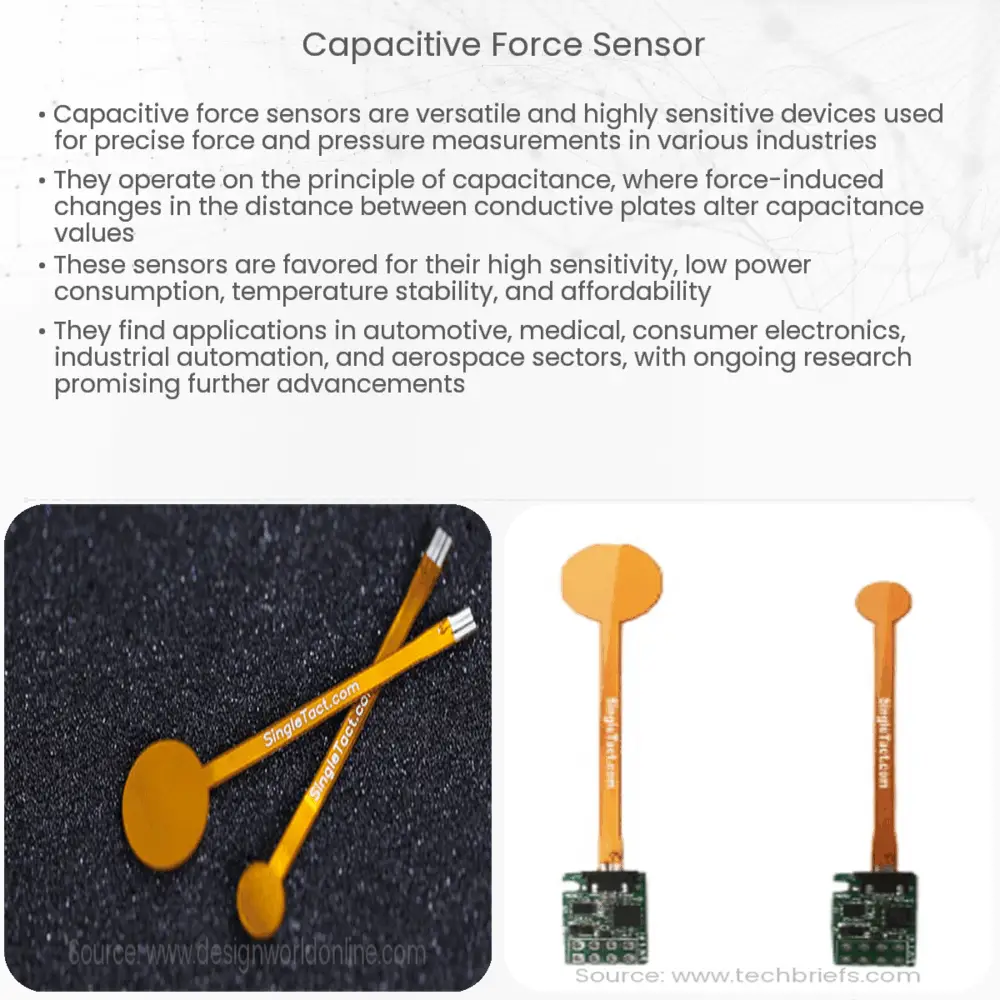Capacitive force sensors are highly sensitive, low-cost devices used for precise force and pressure measurements across various industries.

Capacitive Force Sensors: An Overview
Introduction
Capacitive force sensors are versatile, highly sensitive devices that are widely used in various industries for precise force and pressure measurements. They have gained significant popularity due to their remarkable characteristics such as low cost, low power consumption, and high sensitivity. In this article, we will explore the fundamentals of capacitive force sensors, their working principle, and their applications across different industries.
Understanding Capacitive Force Sensors
Capacitive force sensors operate based on the principle of capacitance, which is the ability of a system to store an electrical charge. A capacitive sensor typically consists of two conductive plates separated by a dielectric material. When a force is applied to the sensor, the distance between the plates changes, altering the capacitance value. This change in capacitance is then measured and translated into a force reading.
Capacitive force sensors offer several advantages over other types of force sensors, such as piezoresistive and piezoelectric sensors. Some of these advantages include:
- High sensitivity: Capacitive sensors can detect minute changes in force, making them suitable for applications that require high-resolution measurements.
- Low power consumption: These sensors consume very little power, which is crucial in battery-operated devices and systems with limited power resources.
- Temperature stability: Capacitive sensors exhibit excellent temperature stability, allowing them to operate reliably over a wide range of temperatures.
- Low cost: Capacitive force sensors can be manufactured at relatively low cost, making them an attractive option for various applications.
Working Principle
The working principle of capacitive force sensors is based on the capacitance equation:
C = (ε * A) / d
Where:
- C is the capacitance,
- ε is the permittivity of the dielectric material,
- A is the overlapping area of the conductive plates, and
- d is the distance between the conductive plates.
When a force is applied to the sensor, the distance between the conductive plates (d) changes, causing a change in capacitance (C). This change in capacitance is proportional to the applied force and can be measured using various techniques, such as frequency shift, voltage change, or current change.
Capacitive force sensors can be designed in various configurations to suit different applications, including single-plate, parallel-plate, and interdigitated capacitive sensors. Each of these configurations offers unique advantages and can be selected based on the specific requirements of the application.
Applications of Capacitive Force Sensors
Capacitive force sensors are utilized in a wide range of applications across various industries, owing to their excellent characteristics. Some of the most common applications include:
- Automotive: Capacitive force sensors are used in automotive systems for detecting tire pressure, monitoring the load on suspension systems, and measuring fluid levels.
- Medical: In the medical field, capacitive sensors are employed for precise force measurements in applications such as blood pressure monitoring, infusion pumps, and drug delivery systems.
- Consumer Electronics: These sensors are integrated into devices like smartphones, tablets, and wearables for touch-sensitive interfaces, button replacement, and gesture recognition.
- Industrial Automation: Capacitive force sensors are utilized for monitoring pressure in hydraulic systems, detecting the presence or absence of objects, and measuring the force exerted by robotic arms.
- Aerospace: In aerospace applications, capacitive sensors are used for monitoring the pressure in fuel tanks and measuring the force exerted on aircraft components during flight.
Future Developments
As technology advances, capacitive force sensors are expected to become even more prevalent in various applications. Researchers are continuously working on improving the performance of capacitive sensors, with a focus on:
- Increased sensitivity: Developing new materials and sensor designs to enhance sensitivity and enable the detection of even smaller changes in force.
- Improved temperature stability: Exploring new materials and techniques to further enhance the temperature stability of capacitive force sensors, ensuring reliable operation under extreme conditions.
- Miniaturization: Advancements in fabrication technologies are paving the way for smaller, more compact capacitive sensors, which can be integrated into a wider range of devices and systems.
- Wireless communication: Incorporating wireless capabilities into capacitive force sensors will allow for easier integration and remote monitoring of sensor data, enabling the development of more advanced applications and systems.
Conclusion
Capacitive force sensors are an essential component in a variety of applications across different industries. Their high sensitivity, low power consumption, temperature stability, and cost-effectiveness make them an attractive choice for numerous force and pressure measurement tasks. With ongoing research and development efforts, capacitive force sensors are expected to continue to evolve, paving the way for new and innovative applications in the future.

